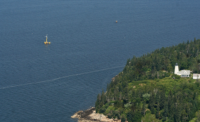Blame the U.K.’s June 23 vote to leave the European Union—the Brexit referendum—as well as construction challenges, for hesitation in the development of lightweight floating foundations for wind turbines sited in deep waters off Scotland and England.
“The political situation is very uncertain in Scotland following Brexit,” says Bill Hurley, chairman of Glosten Associates, a naval architecture and marine engineering firm in Seattle, and development director of PelaStar, one of two such projects moving toward deployment. “We’re surfing through political changes and challenges in the initial development of floating wind.”
Three designs are in tests, including validation of construction schemes. The designs are called “tension leg platforms” (TLP) for the way anchoring cables and the platforms’ buoyant, submerged foundations are held in tension to stabilize the turbines and rotors high above the open sea.
A TLP is not stable without a mooring system connected. Constructors will need a transport-and-installation system to guarantee stability and safety of the platform during deployment, according to Offshore Renewable Energy (ORE) Catapult, a nonprofit offshore-wind-and-tidal-energy research center in Blyth, England.
Development drivers are economics and opportunity. “There are immense wind resources in water depths greater than 50 meters,” explains Hurley, “plus they have the benefit of higher wind quality and can be further from shore [and] out of view. The best wind sites in shallower waters are soon to be taken, so if offshore wind continues to prove a cost-competitive renewable energy source, it will move to deeper waters.”
With the current designs in development, floating foundations would become more cost-effective than fixed-jacket foundations at sites somewhere between 40 m and 50 m deep, says Hurley. The competition now between designs is to create stable foundations of the lightest possible weight and to push the projected cost advantage over fixed foundations to waters of 30 m.
“Less steel weight is important for capital cost reduction,” says Hurley, adding that all of the floating concepts avoid the construction cost of jack-up barges and the large, expensive turbine installation vessels needed to set fixed foundations.
Hurley’s firm is involved in the most advanced project in terms of testing and regulatory certification: the 6-MW PelaStar system, which has been in development since 2006. The project has received more than $6 million in funding from the Energy Technologies Institute in the U.K. and $1 million from the U.S. Dept. of Energy.
“We’ve completed a FEED [front-end engineering design] level of design and have a construction plan in place costed out,” Hurley says.
The PelaStar design has been tested at the Wave Hub Test Site off Cornwall, England.
“Floating wind is likely to be an extremely important technology as we aim to drive down the overall cost of renewable energy,” says Gavin Smart, an investment and financial analyst for ORE Catapult. The nonprofit, together with partners at Scotland’s University of Strathclyde, is participating in the development of a £1-million ($1.3-million) TLP wind project called TLPWIND. It is led by Spain-based Iberdrola Engineering & Construction.
On June 26, TLPWIND’s floating foundation successfully completed wave-tank tests of both the TLP model and models of a construction support system in a lab at Strathclyde. The lab simulated extreme ocean conditions found off the country’s northeast coast. The TLPWIND Project is designed for depths of 81 m (266 ft).
A 1-to-36-scale model tested the 5-MW, 940-ton floating system’s design. The test tank replicated conditions off the Aberdeen coast of Scotland with waves up to 52 ft and wind gusts reaching 161 ft per second.
Sandy Day, professor of marine hydrodynamics in the naval architecture ocean and marine engineering department at Strathclyde and director of the hydrodynamics lab, said, “This technology has been shown to work and reduce cost. We carried out rigorous testing of the scale models and found that even under stressful conditions, the platform is both stable and robust.”







Post a comment to this article
Report Abusive Comment